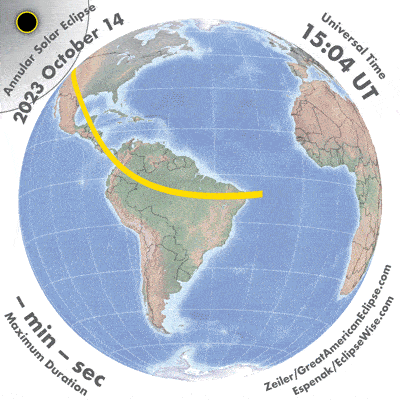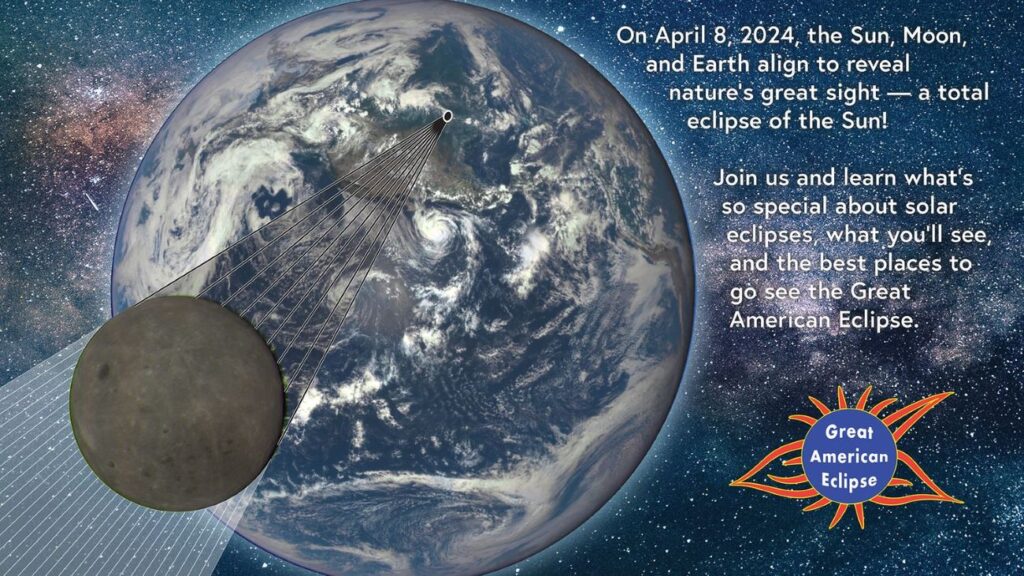Introduction
Mark your calendars for Saturday, Oct. 14, 2023, as North America prepares for a celestial extravaganza—the annular solar eclipse. In this comprehensive guide, we’ll delve into the intricacies of this rare event, covering how, when, and where to witness it. This is your chance to experience the captivating “ring of fire” as the moon takes center stage between the Earth and the sun. NASA has also released an interactive map where you can track the annual solar eclipse of 2023

Understanding the Annular Solar Eclipse
An annular solar eclipse is a captivating celestial event that occurs when the moon positions itself directly in front of the sun but appears slightly smaller. Consequently, it leaves the outer edges of the sun visible, creating a mesmerizing “ring of fire” effect. This stands in contrast to total solar eclipses, where the moon completely obscures the sun.
Where and When to Catch the Annular Solar Eclipse 2023
This spectacular phenomenon will be visible from a specific region in North America, spanning eight U.S. states from Oregon to Texas. NASA draws parallels between this eclipse and one that occurred on May 20, 2012. The path of annularity, where the “ring of fire” will be at its peak, extends from Oregon through Texas and beyond.

This map illustrates the extent to which the moon will obscure the sun based on your location during the annular solar eclipse occurring on October 14, 2023. The image is sourced from GreatAmericanEclipse.com.
Impact on Navajo Tribal Parks
In September 2023, it was announced that all Navajo Tribal Parks would be temporarily closed from 8:00 a.m. until 1:00 p.m. MDT on October 14, 2023. This closure is rooted in Navajo cultural beliefs tied to the eclipse. It includes iconic sites such as Monument Valley Navajo Tribal Park, Four Corners Monument Navajo Tribal Park, and portions of the Tséyi’ Diné Heritage Area within Canyon de Chelly National Monument. Local businesses may also adhere to this closure, so plan your eclipse-viewing trip accordingly.
Prime Eclipse-Viewing Locations
To witness the full splendor of the “ring of fire” during the annular solar eclipse, selecting the right location is paramount. Below is a list of prime viewing locations, complete with eclipse timing and duration:
| Location | Time of Eclipse | Duration |
| Oregon Dunes, Oregon | 9:15 a.m. PDT | 4 minutes, 29 seconds |
| Crater Lake National Park, Oregon | 9:17 a.m. PDT | 4 minutes, 19 seconds |
| Lava Beds National Monument, California | 9:19 a.m. PDT | 54 seconds |
| Great Basin National Park, Nevada | 9:24 a.m. PDT | 3 minutes, 46 seconds |
| Bryce Canyon National Park, Utah | 10:27 a.m. MDT | 2 minutes, 31 seconds |
| Capitol Reef National Park, Utah | 10:27 a.m. MDT | 4 minutes, 37 seconds |
| Canyonlands National Park, Utah | 10:29 a.m. MDT | 2 minutes, 24 seconds |
| Natural Bridges National Monument, Utah | 10:29 a.m. MDT | 4 minutes, 29 seconds |
| Mesa Verde National Park, Colorado | 10:31 a.m. MDT | 2 minutes, 57 seconds |
| Chaco Culture National Park, New Mexico | 10:32 a.m. MDT | 4 minutes, 42 seconds |
| Albuquerque, New Mexico | 10:34 a.m. MDT | 4 minutes, 42 seconds |
| San Antonio | 11:52 a.m. CDT | 4 minutes, 5 seconds |
| Corpus Christi, Texas | 11:55 a.m. CDT | 4 minutes, 52 seconds |
| Padre Island National Seashore, Texas | 11:56 a.m. CDT | 4 minutes, 52 seconds |
| Edzná Maya archaeological site, Yucatán Peninsula, Mexico | 11:23 a.m. CST | 4 minutes, 32 seconds |
These locations offer varying durations of the “ring of fire” and promise a unique perspective on this celestial marvel.
Weather Watch
While selecting the perfect location is essential, monitoring the weather is equally critical. Clear skies are indispensable for a successful eclipse-viewing experience. We recommend keeping an eye on local weather forecasts and being flexible with your location based on short-term weather conditions.
Eclipse Chasers’ Delight
While some enthusiasts will position themselves along the path of annularity, others may opt for a more dramatic albeit shorter spectacle. Experienced eclipse chasers often head to the northern edge of the eclipse’s path, at locations like Dolores, Colorado, and Santa Fe, New Mexico. Here, you can catch a glimpse of the “Baily’s beads” ring around the moon during the annularity phase, a sight that adds a touch of drama to the event.
Partial Solar Eclipse in Major U.S. Cities
While the “ring of fire” will grace select locations, major U.S. cities will experience a partial solar eclipse on Oct. 14, 2023. Here’s a quick overview of what the 10 largest cities in the U.S. can anticipate:
| City | Eclipse Magnitude |
| New York | 23% at 1:22 p.m. EDT |
| Los Angeles | 71% at 9:24 a.m. PDT |
| Chicago | 43% at 11:58 a.m. CDT |
| Houston | 85% at 11:58 a.m. CDT |
| Phoenix | 79% at 9:31 a.m. MST |
| Philadelphia | 25% at 1:21 p.m. EDT |
| San Antonio | Ring of fire” at 11:52 a.m. CDT |
| San Diego | 68% at 9:26 PDT |
| Dallas | 80% at 11:52 a.m. CDT |
| San Jose, California | 75% at 9:20 a.m. PDT |
For your safety, always use solar filters when viewing the eclipse, regardless of whether it’s partial or annular.
Upcoming Eclipse Adventures

Following the annular solar eclipse on Oct. 14, 2023, eclipse enthusiasts can look forward to another celestial treat on Oct. 2, 2024. During this event, a “ring of fire” will grace the Pacific Ocean, southern Chile, and southern Argentina. The point of greatest eclipse will offer a stunning spectacle lasting 7 minutes and 25 seconds. Easter Island (Rapa Nui), situated about 2,000 miles off the western coast of Chile, will be the ideal location to witness this event among its ancient moai statues, promising a ring of fire lasting up to 6 minutes and 9 seconds.
In conclusion, the annular solar eclipse of 2023 is a cosmic phenomenon that should not be missed. Whether you’re within the path of annularity or observing from a major city, this rare event offers a unique glimpse into the wonders of our universe. Prioritize safety and stay tuned to weather updates for an unforgettable eclipse experience.
Explore further.
If you’re interested in looking into the future, you can discover a brief overview of solar eclipses up to the year 2030 on NASA’s Eclipse website. For more information on both solar and lunar eclipses, you can visit Eclipse Wise, a dedicated website for eclipse predictions. Additionally, you’ll find detailed maps on GreatAmericanEclipse.com, created by eclipse cartographer Michael Zeiler, and interactive Google Maps on Xavier Jubier’s eclipse website. For climate and weather forecasts related to eclipses, you can turn to meteorologist Jay Anderson’s insights on Eclipsophile.com.
